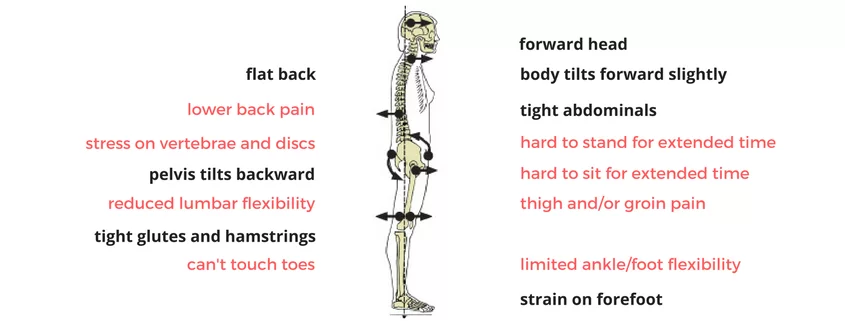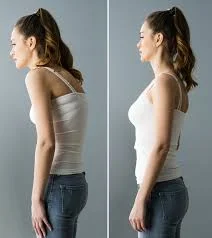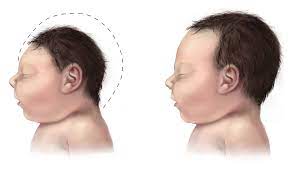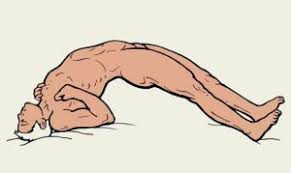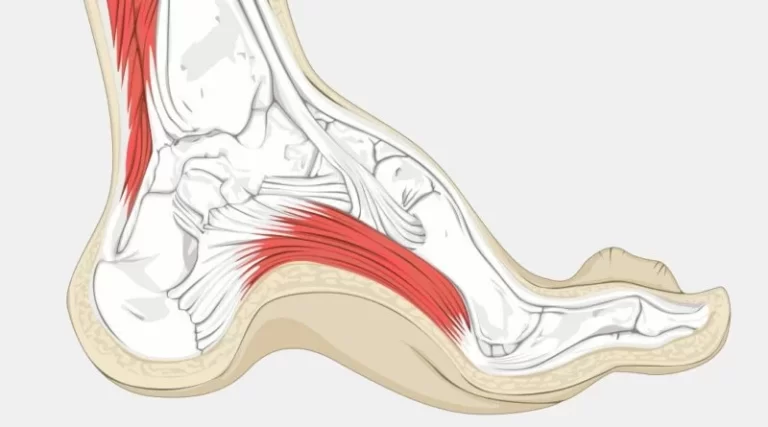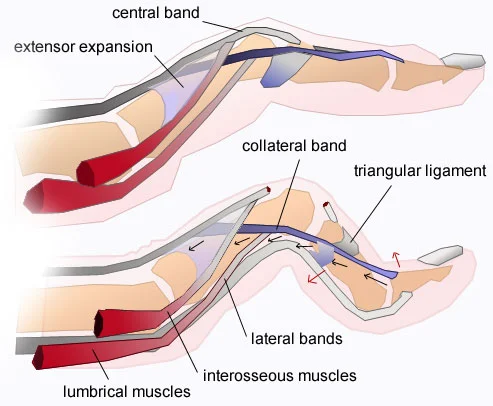Flat Back Posture
Table of Contents
What’s a Flat Back Posture?
- Flat back posture is when the lower part of your back flattens out, losing its normal curve in your spine and tipping your pelvis backward. The spine has a natural curve. It has 2 curves forming an “ S ” shape. When you have a flat back posture the spine loses the lower curve and becomes flat. This causes the spine to become imbalanced and the patient tends to incline forward.
- If you have a flat back you may have trouble standing up straightway or have constant back pain or leg pain. The flat back posture may develop due to degenerative disc disease, compression fractures, or ankylosing spondylitis disease.
Anatomy of the spine
- To Understand Flat Back Posture, You must understand the anatomy of the spine and its function of the spine. The spine is a column of twenty-four movable bones called vertebrae that are connected to one another by ligaments. The bones are divided by discs, which act as shock absorbers and give the spine curve flexibility. This vertebra has a three-joint complex with a disc located in the front and two facet ( pronounced fah- CETTE) joints in the back. This strong, tripod design keeps the bones connected and aligned, one on top of the other, while having our spine curve to flex and twist Spine Anatomy And Curvature
Spine Anatomy And Curvature
- The human spine has natural curvatures. When you feel at the back from behind, the spine should be straight and centered over the pelvis. still, when you look at the spine from the side, the curves are designed to maintain balance as the spine is behind organs in the chest and stomach. The spine has two alternating curves to create an “ S ” like shape. In the neck and low back, there’s generally an inward curvature or sway back posture known as lordosis. In the thoracic spine and sacrum, there’s an outside curvature known as kyphosis posture or hunchback. These curves generally balance out each other so that when the patient stands they’re well balanced with their head straight above their hips when viewed from the side. Standing in this position minimizes the effect of gravity and allows the patient to stand with good posture and use the least energy when moving or walking activity.
Definition
- A flat back syndrome is an atypical condition where the spine loses its natural low back curve to become flat. The spine curve becomes imbalanced and the patient leans forward.
Introduction
- Patients with flat back postures generally notice trouble standing upright or have ongoing back pain or leg pain. Symptoms generally worsen as the day goes on and the patient feels they lean further and further the longer they try to stand upright. The severity of the symptoms generally depends on the amount of curvature present and difficulties with standing erect.
- In cases with flat back posture, a loss of normal lumbar curvature causes an imbalance of the spine curve. The patient’s head begins to lean forward position, away from the body and they may have trouble standing upright. This imbalance can cause muscle fatigue and muscle pain.
Causes of flatback posture :
- today, the term flat back posture has been broadened to include any patient with a decrease in lumbar lordosis-causing symptoms. As similar, a flat back posture can as a result of any condition that shortens the frontal portion of the spine, causing the patient to lean forward. The flat back posture may develop as the result of the following causes Degenerative Disc Disease, Lumbar Post Laminectomy Syndrome, Compression Fractures, and Ankylosing Spondylitis disease.
- Degenerative Disc Disease For some patients, progressive degeneration of the intervertebral discs or the shock absorbers of the spine may lead to a loss of height in the frontal part of the spine. As discs degenerate the spine begins to lean forward and lumbar lordosis posture decreases. The patient may develop pain as a result of the degenerative disc disease or as a result of the spinal curve imbalance.
- Lumbar Post Laminectomy Syndrome Lumbar flat back posture may develop in patients previously treated with a laminectomy or other lumbar surgery to decompress the spinal nerves to treat stenosis. These processes can lead to a drop in lumbar lordosis and in some cases spinal instability.
- Vertebral Compression Fractures Compression fractures are frequently the result of weak spinal bones due to osteoporosis. A fracture can lead to loss of height of the bone in the thoracic region and lumbar spine. This may occur in one bone or in many bones throughout the spinal column, resulting in a flat back posture.
- Ankylosing Spondylitis: Ankylosing spondylitis( AS) is a chronic inflammatory disease that causes stiffness and arthritis throughout the whole spine. Some patients with Ankylosing spondylitis notice an increasing forward posture of the spine, involving an increase in thoracic kyphosis or a decrease in lumbar lordosis. This can lead to symptoms of the lumbar flat back posture.
Symptoms of Flat Back:
In addition to the appearance of their backs, persons with a flat-back posture may also have
- A sensation of falling forward
- Chronic pain in the back muscles
- Difficulty with certain daily activities
- Fatigue back muscles
- Stooping at the end of the day
- Many patients with a significant flat-back posture deformity require a cane or a walker to help them when walking because they’re stooped forward and their weight isn’t centered over their pelvis and leg area. The condition can be a source of significant pain, disability, and frustration.
- Forward head posture The head is poked forward position.
- Rounded shoulders The shoulders are slouched forwards.
- Flat thoracic( upper back) spine Lack of upper back natural curve( Thoracic Hypokyphosis)
- Flat lumbar( lower back) Lack of lower back natural curve( Lumbar Hypolordosis)
- Posterior pelvic tilt The pelvis is rotated backward.
a) Flat thoracic spine
- This is where there’s a loss of natural curve( kyphosis) in the upper back.
The thoracic spine is locked into an extension.
Cause: This occurs when the thoracic spine attempts to position the shoulders and head( which are generally slouched forwards in most people) into an additional upright position.
Muscles responsible
- Spinal thoracic
- Iliocostalis thoracic
- Longissimus thoracic
- Posterior intercostals
b) Flat lumbar spine
- This is due to a Posterior pelvic tilt.
This is when the pelvis is rotated backward.
Cause: Sitting with a slouched posture.
This leads to an imbalance of the forces around the pelvis causing a net force to tilt backward.
Muscles responsible
Tight/ overactive
- Hamstrings muscle
- Abdominal muscles
- Gluteal muscles
Weak/ inhibited
- Lumbar paraspinal
- Hip flexors muscles
How Diagnosis is done in a Flat Back posture?
- The diagnosis of the lumbar flat back posture is made based on the patient’s history and x-rays of the spine. The patient generally has difficulty standing upright and may complain of reverse pain or leg pain. Previous surgical history is important, involving the specific details of any past processes. It’s weighty to determine if the flat back posture is the result of a stable spinal structural abnormality or spinal instability. It’s also important to determine if there’s continued pressure on nerves where spinal stenosis is present.
Treatment for flat back posture :
- Many patients with lumbar flat back postures may be treated without surgery. Initial treatment generally involves an appropriate Physiotherapy Guided exercise routine to involve aerobic fitness, weight-bearing exercise, and core muscle strengthening. The physiotherapist also uses spinal manipulation techniques that may also be beneficial depending on the patient’s symptoms of flat back posture.
Medical treatment
- Medications are generally used to manage symptoms of a lumbar flat back posture. Conditioning and endurance exercise may provide enough strength that also helps to relieve symptoms. For patients with joint arthritis or pinched jitters, spinal injections can also provide pain relief.
- Some patients with structural problems or severe spine curvatures may ultimately require surgical reconstruction. The aim of lumbar flat back posture surgery is to improve the patient’s muscle pain and spinal alignment. The surgery goal is to restore a further normal alignment of the spine to decrease stress on supporting muscles of the back, hip muscles, and leg muscles.
Surgery
- Surgery may be an option if nonsurgical treatments don’t relieve symptoms. Surgery may be needed for patients whose deformity is worsening over time, or who have spine curvatures leading to nerve compression causing symptoms similar to numbness, weakness, or muscles pain. Surgical reconstruction for flat back posture involves some correction of the spine curve. The pretensions of surgery are to alleviate pain and help the curvature from getting worse in the future.
- Surgery to correct flat back posture deformity may be performed from multiple or combined approaches. The final recommendation is based on the desire to produce the least invasive and safest procedure for each patient.
Physiotherapy treatment
Flat thoracic spine
a) Releases
Thoracic para-spinal
Instructions
- Place your whole body weight on a massage ball in the areas to the sides of the spine and between your shoulder blades.
- Find all of those tender areas!
- Roll over the ball in a circular motion.
- Spend at least five minutes doing the whole area.
- Don’t place the ball directly on the spine.
- Massage for Thoracic paraspinal muscle
b) Stretches
Stretch into flexion
Instructions
Upper back stretch

- Whilst sitting, interlock your fingers behind your neck area.
- Proceed to kindly drag your neck downwards.
- Focus on flexing at the upper back as much as possible.
- Goal to feel a stretch in your thoracic spine area.
- Hold for 30 seconds.
- Take deep breaths whilst in this position and see the air expanding the area between your shoulder blades.
Stretch with a foam roller
Instructions
- Whilst sitting position, place a foam roller on your lap.
- flex and round your back whilst your chest are in contact with the foam roller.
- Focus on flexing at the upper back as much as possible.
- The goal is to feel a stretch in your thoracic spine area.
- Hold for 30 seconds.
- Take deep breaths whilst in this position
- see the air expanding the area between your shoulder blades
c) Joint mobilization
Rotations
Instructions
- Get into the 4- point kneeling position.
- Place one hand behind your head.
- Proceed to twist your body to the side where the hand is on your head.
- To isolate the thoracic region
- Don’t allow your lumbar spine to move
- Brace your abdominal muscles.
- Keep your rib cage low.
- Repeat 20 times.
- Repeat on the different side.
thoracic kneeling for the upper back
Translations
Instructions:
- Whilst keeping your pelvis stationary, slide your upper torso to the side.
- Try to also lift the shoulder on the side you’re sliding to.
- Goal to feel a stretch on that side of your torso.
- Alternate both sides.
- Repeat 15 times.
d) Improve Control
Standing intersegmental cat/ cow
Instructions
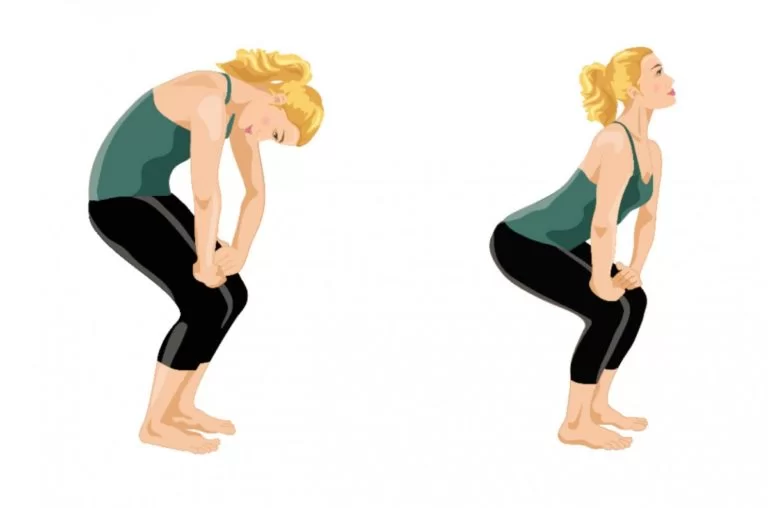
- Cat and cow pose in standing detail
- Cat and cow pose in standing
- Whilst standing position, wrap your arms around an exercise ball as much as you can.
- Try to get your fingers tips to feel.
- Starting from the neck area Proceed to round your spine down one vertebra at a moment until you reached back.
- Emphasize the rounding over the areas where your spine curve is the flattest.
- From here, back your movements back to the beginning.
- Repeat 20 times.
Intersegmental cat/ cow
Instructions
Cat and cow position

- Get into the 4- point kneeling position.
- Hands in line with the shoulder joint. knees in line with the hip joint.
- Starting from the neck Proceed to round your spine down one vertebra at a time until you reached back.
- Emphasize the rounding over the areas where your spine curve is the flattest.
- From here, back your movements back to the beginning.
- Repeat 20 times.
e) Regain your natural curve
- It may take some practice but you want to keep a slight natural spine curve in your upper back at all moments.
- still, your thoracic spine will likely just go back to being flat again, If you don’t do this.
Flat lumbar spine
a) Releases
Hamstrings
Instructions
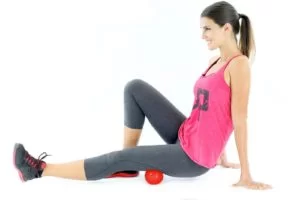
Hamstring release with a massage ball
- Place your hamstrings muscles on top of a massage ball.
- Use your whole body weight to apply pressure onto your hamstrings muscles.
- Make sure to cover the whole hamstring muscles on both sides.
Abdominal
Instructions
- Lie on your abdomen.
- Place a massage ball under your stomach region
- Gently circulate your whole body weight on top of the ball.
- Don’t apply too much pressure.
- NOTE Do NOT squash your organs. STOP if it hurts.
- Use deep breaths to help relax your abdominal muscles.
- Spend at least one or two minutes.
b) Stretches
a) Upper hamstring
Instructions
- Whilst standing, place a slightly flexed knee in front of you.
- Lean forward by hinging at the hips.
- Remember to keep your back straight!
- Goal to feel a stretch in the upper portion of your hamstrings muscles.
- Hold for 60 seconds.
- Alternate legs.
b) Lower hamstring
Instructions

Hamstring stretch
- Whilst standing, place a straight knee in front of you.
- Lean forward by hinging at the hips.
- Remember to keep your back straight!
- Goal to feel a stretch in the mid/ lower portion of your hamstrings muscles
- Hold for 60 seconds.
- Alternate legs.
c) Abdominal
Instructions
Abdominal stretch detail
Abdominal stretch
- Lie on your stomach.
- Place hands on the ground directly under the shoulders.
- Straighten your elbows.
- Arch backward.
- Aim to feel a stretch across your stomach region.
- Breathe and expand your abdomen as you stretch.
- Hold for 60 seconds.
c) Strengthening
Sitting knee lifts
- This exercise is to activate the hip flexor muscles.
Instructions:
- Sit upright.
- Whilst keeping your back still, bring one knee up towards the ceiling,.
- Hold for 5 seconds.
- Alternate on another side.
- Repeat 30 times.
Superman
- This is to activate the lower back muscles.
Instructions:
Superman pose exercise

- Lie on your stomach.
- Stretch out your arms in front of you.
- Lift your upper body and legs off the floor.
- Hold for five-ten seconds.
- Repeat 30 times.
Pelvic tilt (4-point kneel)
Instructions:
- Assume 4 points kneel position. (see above)
- Tilt your pelvis forward.
- Your back should start to arch
- Hold for ten seconds.
- Repeat 30 times.
Pelvic tilt (In sitting)
Instructions:
- Whilst sitting upright, do b to tilt the pelvis forward.
- Hold for 10 seconds.
- Repeat 30 times.
Glute muscles strengthening :
Glute muscle strengthening exercise
The glute bridge
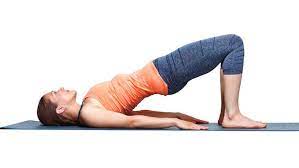
This exercise targets the glute muscles and the hamstrings muscles.
- Lie on the floor, face upward, and knees bend.
- Place the feet hip-width apart.
- Squeeze the abdomen muscles so that the back is flat against the ground. Keep the abdominal muscles engaged throughout the exercise.
- Breathe out and lift the hips off the ground, so the upper body and thighs form a straight line.
- Inhale and gently lower the body to the floor.
- Repeat 10 to 20 times.
d) Maintain a neutral pelvis
- If you don’t maintain a neutral position of the pelvis throughout the daytime. However, then your posterior pelvic tilt will continue to be an issue If you don’t maintain a neutral position of the pelvis throughout the daytime.
- Make sure that you tilt your pelvis forward to a neutral position whilst you’re walking, standing, sitting, etc.
- As your body has had this posture for a long time now, it’ll try to go back to it as a default setting. You need to resist this to help with recurrent back pain and postural abnormality.
Other areas to consider
If you have a Flat back posture, then you will most likely have:
- Forward head posture
- Rounded shoulders
a) Forward head posture:
Sub-occipital release
sub-occipital release with the ball
instructions:
- Place the ball underneath the base of the skull.
- Gently rotate your head on top of the ball.
- Continue for 3-5 minutes.
- Do both sides.
Chin tucks + nods
Instructions:
chin-tuck exercise
- Gently tuck your chin in.
- “Make a double chin”
- The goal is to feel a gentle lengthening sensation at the back of your neck.
- Make sure to keep your eyes and jaw level. Move the head horizontally backward.
- Think of the movement as a book sliding back into the shelf.
- Whilst maintaining this position, nod your chin down.
- Hold for five seconds and repeat 30 times.
b) Rounded shoulders:
Chest stretch
Instructions:
- Place both hands on the door frame.
- Lunge forward.
- Do not flare out your ribs.
- You should feel a stretch in the front part of your shoulder muscles/chest region.
- Hold for 30 seconds.
Elbow flares
Instructions:
- Start position: Place both hands on the sides of your head.
- End position: Drag your elbows all the way back.
- The goal is to feel your shoulder blade muscles contract.
- Hold for five seconds.
- Repeat 20 times.
Why do exercises for flat back posture?
- The curve of your spine plays an important part in spine health, positioning your head over your feet, minimizing the effort of postural muscles, and allowing space between vertebrae for nerves. When you lose that curvature, those spaces can become smaller. Your body has to work harder throughout the daytime. And all of this can cause muscle pain, tingling, or numbness.
- Addressing the muscular deficiencies through exercise brings you closer to your natural lumbar lordosis( spine curvature), and helps prevent the pain associated with pressure on the nerves. Even though you may not have pain anymore, it’s wise to be proactive, as a flat back syndrome can become a painful condition if left unchecked.
Flat Back posture Exercises
The muscular deficiencies that patients with flat back posture suffer from include
- Tight hamstrings muscles, pull the pelvis, and rotate it abnormally. That condition, in turn, causes.Weakening of the iliopsoas muscle( made up of the iliacus and psoas hip muscles), which aren’t being used normally when the back is flattened out.
- Weakening of the abdominal muscles.
- To correct these muscle imbalances, flat back posture physical therapy aims to accomplish three things
- Stretch and flex the hamstrings muscles.
- Strengthen the iliopsoas muscle.
- Strengthen the core muscles.
- The following exercise, done in combination, is a good approach to addressing flat back posture
There are many ways to release muscles, including
- flexing over from a standing position and touching the floor.
- Use foam rollers to assist loosen up the tightness in your hamstrings muscles.
- Try massage therapy, which helps to relax the hamstrings muscle.
Strengthen the iliopsoas muscles.
- Sit in a chair and march in place, raising your knees toward your head by lifting your feet up off the floor. The primary muscle you’re using in this exercise is the iliopsoas muscle
Strengthen the core muscles.
Try one or both of these exercises to strengthen your upper stomach muscles
- The locust — Lay on your abdomen on a mat, with your hands at your sides or on your lower back. Raise your head and shoulders off the mat.
- The bird dog Gets down on your hands and knees, hips over knees, hands under shoulders area, so you form a lovely square.
- Raise your left leg and your right arm, balancing on the opposite hand and knee joint. Hold that position for a count of five.
- Then switch to the opposite side.
Ergonomics
Sitting posture
- Be sure the back is aligned against the back area of the office chair. Avoid slouching or leaning forward position, specifically when tired from sitting in the office chair for a prolonged time.
- For long-term sitting, similar to an office chair, be sure the chair is ergonomically designed to support the back correctly and that it’s a custom fit When sitting on an office chair at a desk, arms should be bent at a 75 to 90- degree angle at the elbows. If this isn’t the case, the office chair should be adjusted accordingly
- Knees should be even with the hips, or slightly higher when sitting in the office chair
- Keep both feet flat on the floor. However, a footrest can be used along
- If there’s a problem with feet reaching the ground comfortably with the office chair
- Sit in the office chair with shoulders straight position
- Don’t sit in one place for too long, even in ergonomic office chairs that have good whole-back support. Get up and walk around and stretch as needed.
Standing Posture
- Stand with weight mainly on the balls of the feet, not with a load on the heels
- Keep feet slightly apart, about shoulder-width
- Let arms hang naturally down the sides of the body
- Avoid locking the knees
- Tuck the chin in a little to keep the head position
- Be sure the head is square on top of the spine area, not pushed out forward
- Stand straight and tall, with shoulders upright
- still, shift weight from one foot to the other, or rock from heels to toes, If standing for a long period of time.
- Stand against a wall with shoulders and bottom touching the wall area. In this position, the back of the head should also
- touch the wall area – if it does not, the head is carried too far forward.
standing and walking ergonomics
Walking Posture
- Keep the head up and eyes looking straight ahead
- Avoid pushing the head forward
- Keep shoulders correctly aligned with the rest of the body
Driving Posture
- Sit with the back forcefully against the seat for correct back support.
- The seat should be a correct distance from the pedals and steering wheel to avoid leaning forward or reaching
- The headrest should support the middle of the head to keep it upright. Tilt the headrest forward if possible to make sure
- that the head-to-headrest distance is not further than 4 inches.
driving ergonomics
- correct position while driving
- Posture and Ergonomics While Lifting and Carrying
- ergonomics in lifting weighty objects
- The correct method of lifting heavy weight
- Always flex at the knees, not the waist.
- Use the large leg and abdomen muscles for lifting, not the lower back Still, get a supportive belt to help maintain good posture while lifting objects.
- If necessary. When carrying a heavy or big object, keep it close to the chest still, and switch arms constantly
- If carrying something with one arm. When taking a backpack or purse, keep it as light as possible, balance the weight on both sides as much as possible, or alternatively from side to side When carrying a backpack, avoid leaning forward position or rounding the shoulders. still, consider using a rolling backpack with wheels, If the weight feels like too much.
Sleeping Posture with Mattresses and Pillows
- A relatively firm mattress is usually best for proper back support, although separate preference is very important.
- Sleeping on the side or back is generally more comfortable for the back than sleeping on the abdomen.
- Use a pillow to provide correct support and alignment for the head and shoulders.
- Consider putting a rolled-up towel under the neck and a pillow under the knees area to support the spine better
- However, a relatively flat pillow placed between the legs will help keep the spine aligned and straight, If sleeping on the side.
FAQ
What is flat back posture?
Flat back posture is when your lower back flattens out, losing the curve in your spine and tipping your pelvis backward
position. This flat-back posture changes the way your muscles work throughout your spine, causing you to stoop forward
and poke your chin out.What causes flat back posture?
Flat back posture may be caused by degenerative disc disease, compression fractures, or ankylosing spondylitis disease.
Flat-back posture may also develop after a surgical procedure such as a laminectomy or a lumbar spinal fusion that does
not maintain the normal curve of lordosis.Can you fix a flat-back posture?
A flat back posture also tends to make you lean your neck and head forwards, which can cause neck and upper back
strain. Exercises to strengthen your core, buttocks, neck and rear shoulder muscles, and back extensions, are
recommended to help correct a flat back posture.How do you sleep with a flat back?
you must provide better support to your body while sleeping. Put a soft pillow beneath your lumbar region and pelvis.
You must either place a flat pillow or no pillow under your head to avoid straining your back muscles.What muscles cause a flat back?
The flatback posture is often a result of muscle tightness in the lower back muscles – particularly in the psoas – or degenerative disc disease,

